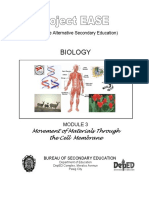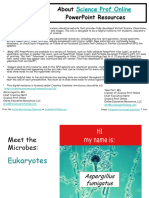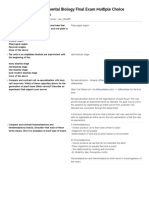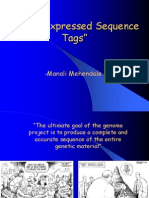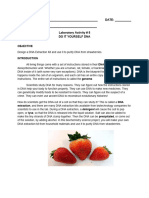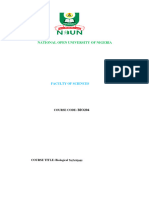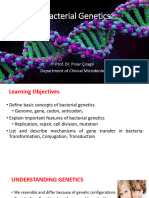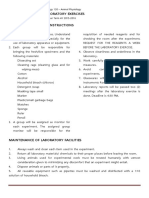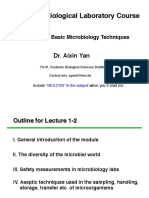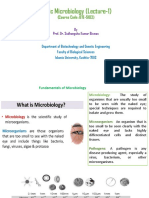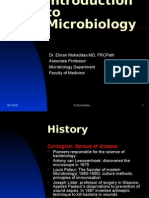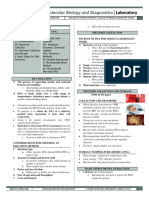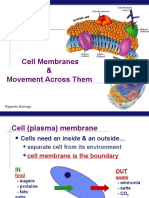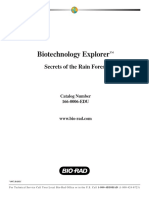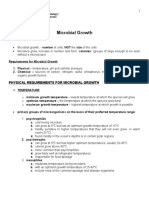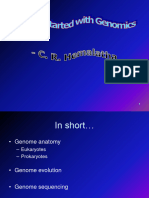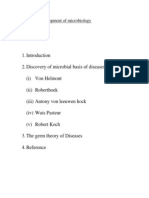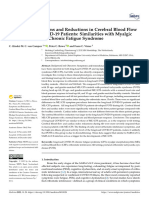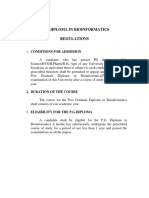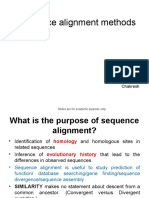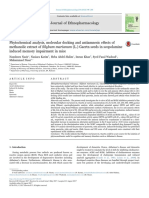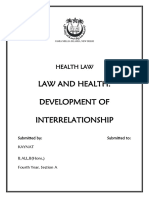Developmental Biology BY1101
P.Murphy
Developmental Biology deals with a multitude of questions arising from the incredible
fact that a single cell, a fertilised egg cell, can give rise to a complex multicellular
organism.
This module will introduce you to two levels of studying developing embryos:
1. Descriptive Embryology and comparative anatomy of the embryo; describing
major events during embryonic development
i.e. descriptions of embryos and how they develop.
2. Molecular and cellular aspects, developmental genetics:
examining how genes influence cell behaviour and bring about changes in the
embryo and how this is all co-ordinated in building an organism
N.B. About these lecture notes: The following notes reproduce the information
presented on slides during the lectures but are more reader friendly than slides and can
serve as revision notes for the course. These notes should free you from transcribing
information in the lectures and allow you more time to think. But it is important to
emphasise that the notes produced here are not designed as a stand alone course; i.e. you
will need to compliment them with the understanding you gain during the lectures and
with your own notes on how the material is making sense to you.
How should you use these notes in conjunction with the lectures?
You might want to print them out and take them with you to the lectures but even if you
dont remember to do that, you wont need to transcribe the text from the slides in the
lecture. The notes will be here for you for lecture review and when it comes to revision.
So if you dont have to transcribe information from the slides in the lectures, what
should you be doing? How will the lectures compliment the information written here?
Not having to transcribe information gives you time to think about the ideas and the
material. You should still make notes- you will retain ideas better if you write them down
in your own words (i.e. not transcribed), so you could make notes on how the material
is making sense to you. These will act as triggers when you are revising the material in
conjunction with the summary notes given here.
Not all of the material here and in the lectures is covered in the textbook (Campbell and
Reece, Biology 9th edition) or in the same order, but reading the relevant chapters
(detailed on next page) in the textbook will also supplement the material in the lectures.
N.B. Not all figures from the textbook are reproduced here but references to specific
figures are blended into the notes, so you will need to refer to the textbook in conjunction
with the notes.
-----------------------------
�Reading:
Campbell and Reece, Biology 9th edition (2011).
Parts of Chapters 18 (18.2, 18.4, 18.5),
20 (20.2, 20.3),
21 (21.6),
25 (25.5),
and all of Chapter 47
We will also link with some material in chapters 6, 11, 13, 17, and 46 (referred to
where appropriate on slides and in notes)
If you are particularly interested in development and want to read further I
recommend the following text book, however this is more advanced than you will
need for this course
Scott Gilbert,
Developmental Biology 9th edition, (2010),
Several copies in the Hamilton Library
Lecture 1
An introduction to some of the basic ideas that will be elaborated upon in the following
lectures.
1. An overview of the subject Gentle introduction to the concepts
2. A brief history of the field
How our thinking has changed and evolved with time. It is still
changing and evolving as we continue to learn more.
Introduction and overview:
Developmental Biology deals with a multitude of questions arising from the fact that a
single cell, a fertilised egg cell, can give rise to a complex multicellular organism.
So starting with a single cell a series of processes can lead to production of a very
complex organism. In this course we are not only going to be describing how embryos
develop (embryology), but also considering how the processes of development are
brought about, how individual cells in the embryo change and become specialised for
specialist functions (the cellular level), and how genes within the genome of the organism
drive and guide these changes (the molecular level). So were going to be spanning from
thinking about DNA in the nucleus of the cell, to cells, to whole organisms. We have to
span these levels in the way we think about development because an integration of these
levels is what happens in building the organism during development. We will be
considering genes in terms of the effect they have on the organism- the context in which
they make most sense I believe. So hopefully this course will help you bring together
�your understanding of different aspects of biology- how the regulation of gene expression
impacts on the characteristics and behaviour of a cell and how such events are coordinated in the development of an embryo.
Campbell and Reece Figure 6.2 and the collage below were viewed to remind you of the
scales we will be considering.
Organism scale
Cellular scale
Molecular scale
The scale illustration above (note that it is exponential) compares the scale of whole
organisms (organism scale) with cells (cellular scale)- an animal cell is illustrated in this
case. The image on the right indicates that the chromosomes, residing within the nucleus
of the cell, contain the genetic material with genes located along the chromosomes. In
this course we will be considering how the genes in the genome (molecular scale) have
an impact on cellular behaviour and differentiation (cellular scale) and guide the
formation of the organism (organism scale).
Most multicellular organisms arise by sexual reproduction. Some multicellular organisms
are capable of asexual reproduction, e.g. simple animals such as hydra can reproduce
by budding and some plants can be propagated through cuttings, but the vast majority of
new complex organisms arise from a fertilised egg cell- also called a ZYGOTE. (more
about reproduction in lecture 2)
Hydra reproducing asexually by budding, Campbell and Reece Fig 13.2
�Depending on the genome within a fertilised egg cell- the new individual formed could
be a fish, frog, mouse, fly or human.
In forming a new organism the fertilised egg cell has to give rise to many different cell
types e.g. heart muscle cells, neurons and light sensing cells in the eye, and all these
different cell types are produced progressively as the embryo develops- in the right place
and at the right time
In the development of most multicellular organisms, a single-celled zygote gives
rise to cells of many different types. Each type has different structure and
corresponding function.
Cells of similar types are organized into tissues, tissues into organs, organs into
organ systems, and organ systems into the whole organism.
Thus, the process of embryonic development must give rise, not only to cells of
different types, but to higher-level structures arranged in a particular way in three
dimensions
This complicated organisation must happen progressively as the embryo develops
- development is a highly coordinated series of events.
In the lecture you viewed a time lapse movie of a zebrafish embryo developing over a
17hour period from zygote to advanced embryo to illustrate the co-ordinated nature of the
developmental programme. You will view this again after you have heard about the
various events that are occurring.
There is clearly something very special about a fertilised egg cellIt is the only cell that naturally has the capacity to form a new unique individual
The genes in the genome are the driving force behind development and they are also the
basis of the differences between organisms.
We clearly need to understand the relationship between the genes driving development
and the appearance of the organism.
So the central question in all developmental biology is how to start with a single cell
and end up with a complex multicellular organism, with hundreds of different cell
types, all formed at the correct time and in the correct place to build a functioning
body and perform all the individual functions of life.
This encompasses two major groups of questions that need to be addressed:
1. How do cells differentiate and acquire specialised characteristics?
2. How is the body plan organised?
----------------------------To answer these questions, the study of development brings together:
�Cell Biology: how cells change
Genetics: how genes bring about changes
Gene transcription: how genes are turned on and off
Cell signaling: How cells communicate with each other
And much more.
Developmental Biology is relevant to all of us.
Why?
It impacts on our understanding of ..
How defects in development cause disease
The basis of many cancers.
How to repair when parts of the body are not functioning
Something to think about:
Why does the study of development have such far reaching impact?
Think about a mechanic: If a car starts to show problems a good mechanic needs to know
how the car was designed and how the parts work together to find out the root of the
problem and what needs to be altered / changed. In the same way discoveries from
developmental biology, on how a kidney is formed for example- how the necessary cell
types are produced and organized- will lead to finding ways to cure diseases that affect
development or function of the kidney.
--------------------------------------------------------------------------------
The principles of development.
Three broad interrelated processes are involved in building an embryo.
1. Cell division
Cell division and growth are both tightly regulated during development
2. Cell differentiation.
A complex organism requires many hundreds of different cell types to form structures
and carry out specific functions. For example, red blood cells are required to carry
oxygen, muscle cells are required for movement, neurons are required to receive and
transmit signals. The cells that arise by cell division from the zygote have to become
different to each other over time.
3. Morphogenesis.
Or creation of form. How the organism takes on a three dimensional shape with all the
cells types in the right place to form structures and carry out functions
We will consider Cell Division in lecture 4, Cell Differentiation in Lecture 7 and
Morphogenesis in lectures 8 and 11
�Part 2: A brief history of Developmental Biology
generation of life - how life gives rise to life- has intrigued people since the beginning
of human records.
o Egyptian writings
o Oldest record of investigation- Aristotle 4th century BC- opened chick
eggs
Aristotle believed that there is a generative force in the egg but also believed that the
creative principle (form) came from the male- and so started many centuries of incorrect
misogynistic belief.
Preformation
This was the predominant belief until the mid 19th Century - all organisms are preformed
and contained inside sperm or egg.
Early observations of embryos were poor and re-enforced the idea of preformation Hartsocker, in the late 17th century had improved the microscope and reported that he
could see a preformed human being inside each sperm (illustrated on the right)- he called
it a homunculus
This is an example of poor scienceThe preformationsists in the 17th and 18th centuries saw what they expected to see.
Good science removes subjectivity
Eventually no real evidence for preformation could be found But evidence for the opposing idea of epigenesis was foundEpigenesis- the form of an animal emerges gradually from a formless egg
As microscopes improved through the 19th century it became increasingly clear that what
early embryologists were viewing was a self generated increase in complexity
a single cell gives rise to more cells
cells interact to give rise to tissues
tissues interact to give rise to organs
organs are assembled into an organism
i.e. the basis of what we believe today
The field of Developmental Biology as we know it really only began in the early 19th
century and we could divide progress since then into 4 important phases
1. Descriptive embryology o 2nd 3rd and 4th decades of C19th
o Improved preparation and microscopes led to reliable observations and
development of a suitable vocabulary
o Key figure Karl Ernst von Baer (1792-1876),
First discovered mammalian egg in a dog (1827)
2. Experimental Embryology
�o Late 19th Century, early 20th century
o Manipulated embryos to investigate changes in cells and interactions between
cells during development
o Key figures: Roux, Spemann and others
3. Developmental Genetics
o From the mid 20th Century
o The realisation that certain genes play important roles in guiding development
4. Molecular Developmental Genetics.
o From late 1980so Finding the genes and analysing how they work- what kind of gene products they
make and how these affect development.
Key concepts in lecture 1
1. Developmental Biology deals with a multitude of questions arising from the fact that a
single cell, a fertilised egg cell, can give rise to a complex multicellular organism.
2. In considering this question we need to integrate ideas about how cells change in the
embryo, how genes influence the state and behaviour of cells and how such influences
and changes bring about development- so we need to conceptualise across multiple scales
3. Most multicellular animals arise by sexual reproduction where a fertilised egg- the
zygote- gives rise to many different cell types.
4. The genome within the nucleus of the zygote drives the generation of a particular
organism Development is a highly co-ordinated series of events where the body of the
new organism is generated as the events unfold.
5. The fertilised egg cell is the only cell with the natural capacity to produce a new
organism.
6. Three broad inter-related processes are involved in building an organism
Cell division
Cell differentiation
Morphogenesis
7. In the history of Developmental Biology, the idea of preformation persisted over
several centuries but was finally displaced in the 18th-19th Centuries through the rigour of
scientific analysis.
8. The study of development as we view it today began in the early nineteenth century
with the first infomative descriptions of embryos, and developed through the last two
hundred years with scientists manipulating embryos (experimental embryology) and
studying the genes that guide development (developmental genetics).
�Lecture 1: Learning outcomes: you should be able to.
A) Describe briefly how the three broad inter-related processes; cell division, cell
differentiation and morphogenesis, contribute to building an organism from a
single cell.
B) Distinguish between preformation and the concept of epigenesis and define
epigenesis in terms of how we now envisage development occurring.
C) Generally describe how the field of developmental biology has changed since the
beginning of the 19th century with different phases of developmental research
predominating at different times.
N.B. Lecture 1 served to introduce concepts to prime you for later lectures. It has less
specific learning outcomes than other lectures.
Key terms to be familiar with: cell division, cell differentiation, morphogenesis,
preformation, epigenesis.




